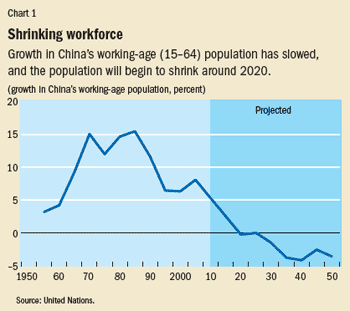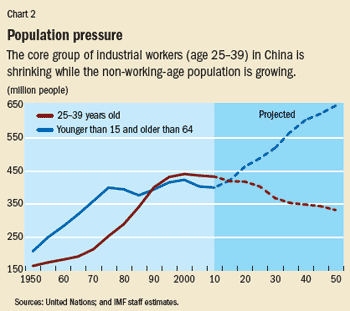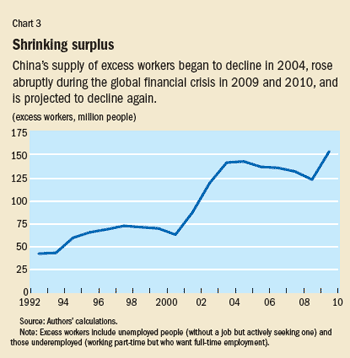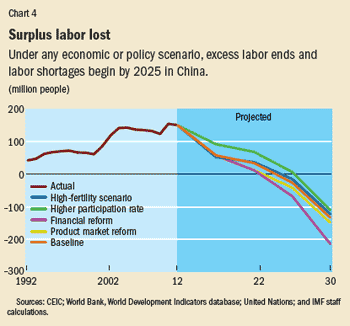The End of Cheap Labor
Finance & Development, June 2013, Vol. 50, No. 2
China’s working-age population is poised to decline, with big implications for China and the rest of the world

Fast-rising wages, worker activism, and intermittent labor shortages suggest that China, whose economic rise has depended on a vast supply of low-cost labor, is about to enter a period of widespread labor shortages.
As China crosses the line from being an economy with plentiful low-cost labor to one with higher-cost workers, the implications for both China and the global economy could be far reaching.
For China, the transformation will likely mean that its extensive growth model—which relies heavily on increasing the number of workers involved in production (called factor input accumulation)—cannot be sustained. As a result, the world’s second largest economy will likely change to an intensive growth model that uses resources more efficiently and would rebalance growth away from investment and toward private consumption. Successful rebalancing in China would, in turn, have significant positive global effects—including increasing output in commodity exporters and in the regional economies that now are part of China’s supply chain. Even advanced economies would benefit (IMF, 2011). Importantly, rising labor costs—which would affect prices, incomes, and corporate profits in China—would have implications for trade, employment, and price developments in key trading partners. For instance, foreign manufacturers may find it increasingly less profitable to produce in China, raising their domestic employment; Chinese goods could become less competitive in global markets, potentially raising export shares elsewhere; and rising Chinese prices could pass through to trading partners that rely heavily on imports from China.
The future of cheap labor
Recent developments in the Chinese labor market seem somewhat contradictory. On the one hand, aggregate wage growth has remained about 15 percent during the past decade, and corporate profits have remained high. Wage growth lags productivity, resulting in rising profits, which suggests that China has not reached the so-called Lewis Turning Point (see box), at which an economy moves from one with abundant labor to one with labor shortages. At the same time, though, since the financial crisis began, industry has increasingly relocated from the coast to the interior, where the large reserve of rural labor resides. As a result, previously large gaps between the demand for and supply of registered city workers have progressively narrowed, and worker demand for higher wages and better working conditions has risen—suggesting the onset of a structural tightening in the Chinese labor market.
The Lewis Turning Point
In Sir Arthur Lewis’s seminal work (1954), developing economies are characterized by two sectors: a low-productivity sector with excess labor (agriculture, in China’s case) and a high-productivity sector (manufacturing in China). The high-productivity sector is profitable, in part, because of the surplus of labor it can employ cheaply because of the low wages prevalent in the low-productivity sector. Because productivity increases faster than wages, the high-productivity sector is more profitable than it would be if the economy were at full employment. It also promotes higher capital formation, which drives economic growth. As the number of surplus workers dwindles, however, wages in the highproductivity sector begin to rise, that sector’s profits are squeezed, and investment falls. At that point, the economy is said to have crossed the Lewis Turning Point.

Demographic developments, on the other hand, are not ambiguous. They portend an imminent transition to a labor-short economy. The United Nations projects that aging and declining fertility will result in a smaller working-age (15–64) population in less than a decade (see Chart 1). The core group of industrial workers (ages 25–39, born at the start of the restriction of couples to one child) will shrink even faster, and the rapidly aging population will reverse a more than half-century decline in the dependency ratio—that is, the number of people younger than 15 or older than 64 divided by the working-age population (see Chart 2).

The looming demographic changes are large, irreversible, and inevitable; they will be key to the future evolution of surplus labor in China. But other factors could slow, or accelerate, this process. More changes in the household registration system, which identifies a person as a resident of a specific region—the so-called hukou reform—could accelerate the move of workers from rural areas to cities. Training workers to meet the skill requirements of industrial jobs could decongest urban labor bottlenecks. Higher fertility rates would likely delay the depletion of surplus labor, but it would take a generation. Although the Chinese primary sector (farming, mining, and other natural resource activities) holds nearly a third of the labor force, agricultural value added was only about one-tenth of 2011 GDP. Increasing agricultural productivity—by raising mechanization to the level in similar countries, for instance—could free up rural workers to offset shortfalls in urban labor demand. By implementing such policies, China could buy some time. The question is how much.
Onset of a turning point

By our estimates, China has had an excess supply of labor—including both unemployed and underemployed workers—for the better part of two decades (see Chart 3). This pool of surplus labor has persisted even though tens of millions of jobs have been created since 1992, and uncounted millions in the previous decade. The number of excess workers rose gradually until 2000, then surged between 2000 and 2004, coinciding with state-owned-enterprise reforms that resulted in large-scale job shedding. After that, though, the pool of unemployed and underemployed workers was reduced by steadily declining growth in the working-age population and strong demand for labor along the rapidly expanding industrial coast. But things reversed again after 2008, with the onset of the global financial crisis. Demand for Chinese labor declined and the number of surplus workers rose abruptly in 2009–10. We estimate that surplus labor was in the range of 150 million workers during those two years.
Even so, demographics virtually guarantee that China will cross the Lewis Turning Point—almost certainly before 2025.
Our baseline scenario estimates the likely course of excess labor, assuming that both market conditions—which affect unemployment, real wage adjustment, total factor productivity, and GDP growth in trading partners, among others—and demographics follow current trends. The scenario also assumes unchanged social and economic policies, such as the hukou reform, the family planning policy that restricts urban couples to one child, and financial reforms that permit market-set interest rates. Currently, authorities set the rates, with a ceiling on deposit rates that is lower than the floor on lending rates.
Under that scenario, we estimate that China’s excess supply of labor already peaked in 2010 and is on the verge of a sharp decline: from 151 million in 2010, to 57 million in 2015, to 33 million in 2020. China is expected to reach the Lewis Turning Point between 2020 and 2025—that is, sometime in that five-year period, demand for Chinese labor will exceed supply. The rapid rate of decline in the excess supply of workers closely follows the projected path of the dependency ratio, which reached its historical trough in 2010 and is projected to rise rapidly hereafter.
Not etched in stone
It is conceivable, however, that the significant demographic transition, rising social needs, and changing external environment could spur Chinese authorities to undertake policy changes, or that market responses could alter the structure of the economy.
For example, in anticipation of tighter labor markets, producers might decide to hasten the transition to more capital-intensive production. Or the government could accelerate hukou reform as part of a larger effort to change the social insurance and pension program—currently, those who work outside their hukou do not automatically qualify for a range of benefits, such as pensions and health care, which has impeded the movement of rural workers to the cities.
Indeed, a number of initiatives to improve urbanization, income distribution, and the technological mix of industry that were outlined in the 12th Five-Year Plan (adopted in 2011) could affect the Lewis Turning Point by shifting either the supply or demand for labor—for example, shifting to more capital-intensive production would likely lower the demand for labor.
Policies like these could delay China’s transition to a labor-short economy. On the other hand, some policy initiatives designed to improve the livelihood of the Chinese people could have the unintended consequence of accelerating the depletion of labor, although this would occur in an environment in which Chinese savers and workers would get higher remuneration. A number of alternative scenarios are possible.

Relaxing the one-child rule: China’s 2010 fertility rate of 1.6 births per woman was among the lowest in the world and much lower than the fertility rate in emerging Asia. Relaxing the one-child policy to increase the fertility rate in line with the UN high-fertility population projections could delay the turning point in China relative to the baseline. However, the potential effects are small: in 2020 the excess supply of labor would rise to 36 million from the 33 million in the baseline estimate, while in 2025 the labor shortfall would be 16 million, compared with 27 million in the baseline estimate. The turning point would still happen between 2020 and 2025. This result is unsurprising: first, higher fertility increases the size of the potential labor force, but with a delay; second, the UN high-fertility variant is a modest increase that lifts China’s fertility rate from 1.6 to just around the replacement-level fertility of 2.1 (see Chart 4).
Raising the labor force participation rate: The percentage of the Chinese working-age population that is either employed or actively seeking employment is high relative to similar countries. But the rate has declined since the mid-1990s—from 0.87 in 1995 to 0.82 in 2010—because of underlying conditions in the economy. Given the disposition toward hiring younger workers, especially among migrants from rural to urban areas, and a relatively low retirement age, this decline reflects the growing share of older workers in the labor force. One method of increasing the participation rate would be to ease the ability of workers in the provinces to move to the cities—that is, to accelerate the part of hukou reform that allows workers to take their benefits with them when they move. Raising the participation rate to 0.85, the average rate of the past two decades, would significantly affect excess surplus labor, causing it to persist beyond 2025 and delaying the Lewis Turning Point five years—to between 2025 and 2030. This is because, unlike fertility, higher participation has an immediate impact on the size of the potential labor force and thus on the supply of labor.
Financial sector reform: Liberalizing interest rates would lift deposit rates, raising the return on the stock of wealth while lowering the flow into wealth. That is because with higher rates on their deposits, households would be able to meet their saving targets more easily (Nabar, 2011). Therefore, households would want to work less and the economy would cross the Lewis Turning Point sooner. In the baseline scenario, the excess supply of labor in 2020 would be in the range of 30 million. A liberalization in the setting of interest rates would likely result in higher rates and would reduce this excess to about 10 million. The turning point would occur shortly after 2020.
Product market reform: Product market reform that raises total factor productivity—roughly, the effect on output changes not attributable to changes in inputs—would raise firms’ profitability and thus the demand for labor. The contribution of total factor productivity (the result of such things as technology, innovation, and improved education) to output growth in China has been positive for the past two decades, but its growth has slowed in recent years. Many of the policies in the 12th Five-Year plan should raise total factor productivity, including those promoting greater competition in the service sector, investment in higher-value-added activities, and innovation. An increase in total factor productivity growth to the average level of the past two decades would have an impact on the timing of the Lewis Turning Point similar to that of financial reform. The difference would be that financial reform would reduce the labor supply, whereas product market reform would increase the demand for labor relative to that projected in the baseline scenario.
Demographics dominate
China is on the verge of a major demographic shift. Within a few years, the working-age population will reach a historical peak and then begin a sharp decline. When this happens, the vast pool of low-cost workers—a core engine of China’s growth model in its recent history—will disappear, leaving behind a profoundly altered economic and social landscape. Estimates of the timing of the Lewis Turning Point are inherently uncertain, and the scenarios we have painted aim to illustrate the various developments that could hasten or delay the inevitable. But the change in China’s labor picture is inescapable. Market and policy responses to declining surplus labor will be largely peripheral to accelerating or delaying the onset of the Lewis Turning Point, because China’s demographics will play the dominant role in the country’s imminent transition to a labor-short economy. ■
Mitali Das is a Senior Economist in the IMF’s Research Department, and Papa N’Diaye is a Deputy Division Chief in the IMF’s Asia and Pacific Department.
This article is based on the authors’ IMF Working Paper 13/26, “Chronicle of a Decline Foretold: Has China Reached the Lewis Turning Point?”
References
International Monetary Fund (IMF), 2011, People’s Republic of China: Spillover Report for the 2011 Article IV Consultation and Selected Issues, IMF Country Report 11/193 (Washington).
Lewis, William Arthur, 1954, “Economic Development with Unlimited Supplies of Labour,” The Manchester School, Vol. 22, pp. 139–92.
Nabar, Malhar, 2011, “Targets, Interest Rates, and Household Saving in Urban China,” IMF Working Paper 11/223 (Washington: International Monetary Fund).
United Nations, Department of Economic and Social Affairs, World Population Database.


